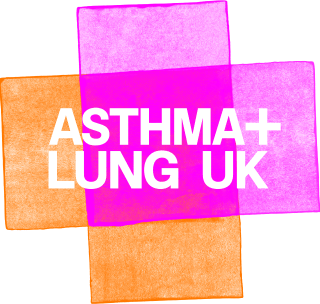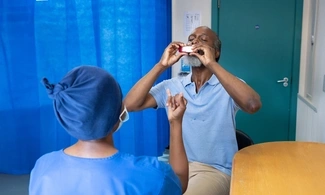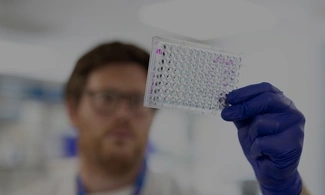Stop smoking
If you smoke, stopping is the best way to stop your COPD from getting worse. It can also help you live longer.
Stopping smoking should improve your COPD symptoms and will make you less likely to have a COPD flare-up (exacerbation).
It’s easier to quit smoking with the right help. We have a lot of advice and support to help you stop smoking, including information about vaping.
Vaccines
If you have COPD, respiratory infections like flu can increase your chance of becoming seriously ill or needing to go to hospital.
Vaccines like the flu vaccine, pneumonia vaccine and COVID-19 vaccine can lower your risk. They are free for people with COPD. If you have a carer, they may also be able get some of these vaccines to protect you.
If you’re aged 75 to 79 years old or are 28 or more weeks pregnant, you are also eligible for an RSV vaccine.
Pulmonary rehabilitation
If you have COPD and your breathing limits what you can do on a day-to-day basis your GP or other respiratory team member should refer you to take part in a pulmonary rehabilitation programme. Pulmonary rehabilitation (PR) is a course of lung physiotherapy for people whose lung condition makes them breathless.
Usually, you’ll go for two sessions a week for at least six weeks. PR is done with a group of people, but the course should be tailored to your specific needs. It will include:
- exercises to help you feel stronger and more energised
- breathing exercises to help you manage your breathlessness
- COPD support and advice to help you understand your condition
- lifestyle advice, for example help with healthy eating
- physical and emotional support.
9 in 10 people who complete a PR course are more able to be active and say they have a better quality of life. PR can also help to reduce flare-ups (exacerbations) and trips to the GP or hospital.
We have more information about PR, including how to get referred for it and all of its benefits.
At Asthma + Lung UK, we also have a Keep Active programme designed by experts to help people with lung conditions get the benefits of physical activity. If you’re waiting for a PR course to start or want to keep up your activity levels after PR, we recommend giving it a try.

Ask your GP for a referral to a pulmonary rehabilitation course. You’ll be surprised how much you’ll learn about your lungs that can make a huge difference to your health.
Learn as much as you can. The more you know, the easier it is to stay on top of things, the brighter you’ll feel and the better your quality of life will be.

Inhalers
An inhaler is a device that delivers medicine into your lungs. Inhalers might help you if COPD affects your breathing or if you have a cough, bring up phlegm (sputum) or get flare-ups (exacerbations).
Before your healthcare professional prescribes you an inhaler, they should check that you know how to use it properly. Using the correct inhaler technique is important because it means that your medicine will work properly. You can also speak to a pharmacist or use our short inhaler videos to check your technique.
There are different types of inhalers that you can use to treat COPD symptoms:
Bronchodilators
Bronchodilators are the name for a group of medicines that relax the muscles in your airways. They open up your airways and make it easier to breathe.
Reliever inhaler (short-acting bronchodilator) for COPD
Short-acting bronchodilators work in a few minutes to relax your muscles, open up your airways and stop symptoms. You might call this your reliever or rescue inhaler.
Short-acting bronchodilators work best for people who get breathless while being active. You can use them up to four times a day. They can help your breathing for four to six hours.
There are two types of short-acting bronchodilator inhalers used to treat COPD symptoms:
- short-acting beta-2 agonist (SABA) inhalers, for example salbutamol and terbutaline
- short-acting muscarinic antagonist (SAMA) inhalers, for example ipratropium.
Long-acting bronchodilators for COPD
If you’re breathless every day, you’ll be prescribed a long-acting bronchodilator. These also relax your muscles and open your airways, but they last for longer than short-acting bronchodilators.
Long-acting bronchodilators can take longer to have an effect when you first use them, but they help your breathing for 12 to 24 hours. As long as you take them regularly, they are always working in the background.
There are two main types of long-acting medicines:
- long-acting anti-muscarinic (LAMA)
- long-acting beta agonist (LABA).
Most people with COPD who are breathless will benefit from taking both LAMA and LABA. Sometimes they come in separate inhalers and sometimes in combination inhalers. You may get on better with one or another combination, but in general they are all thought to be equally effective.
Steroid inhalers for COPD
If you have frequent flare-ups (exacerbations) of your COPD requiring treatment, you may also be given an inhaler with a small dose of steroid in it. Steroid inhalers are also useful for people whose condition has asthma-like features, for example variability from day to day, a past history of asthma or allergies, or higher levels of a type of white blood cell called eosinophils.
Not everybody with COPD needs to use inhaled steroids. If you’re prescribed steroids, your healthcare professional should be able to tell you why you need them.
Steroid inhalers work by reducing inflammation and swelling in your airways over time. You’ll usually be given a combination inhaler with both bronchodilator and steroid medicines in it.
If you’re prescribed steroids for your COPD you should always take them as prescribed, otherwise they will not work properly. Never stop taking your steroid inhalers just because you feel well.
We have more information about taking steroid medication, including information about side effects.
Types of inhalers
There are different inhaler devices available:
- Dry powder inhalers (DPIs). You take DPIs by breathing in as hard as you can, then hold your breath for ten seconds.
- Soft mist inhalers. These turn liquids into a mist that you breathe in.
- Pressurised metered dose inhalers (MDIs). MDIs produce a puff of medication like an aerosol. You take a slow deep breath in and then hold your breath for up to ten seconds. You should always use an MDI with a spacer to help you breathe in the medicine more effectively.
Find out more about different types of inhalers and inhaler choices.
Nebulisers
A nebuliser is a device that can deliver high doses of medicine quickly and easily. It works by changing liquid medicine into a fine mist. You then breathe this mist in through a face mask or mouthpiece.
Rarely, you might be prescribed a nebuliser to use at home if you have more severe COPD or if inhalers are not helping you manage your symptoms.
We have more advice about using nebulisers.
Tablets
Steroid tablets
If you’re having a COPD flare-up (exacerbation), you might be prescribed steroid tablets to help treat it. Usually, you’ll be prescribed a five-day course of prednisolone.
Steroid tablets can help during flare-ups, but they cause side effects if taken at a high dose or for a long time. Longer courses of steroids should only be prescribed by a COPD specialist, and you should be given the lowest effective dose and be closely monitored for side effects.
Side effects of steroid tablets include:
- wanting to eat more and putting weight on
- finding it hard to sleep
- steroid-induced diabetes
- thinning of the bones or osteoporosis
- feeling anxious or having mood swings
- Cushing’s syndrome, which can cause symptoms like a ‘moon-shaped’ face and thin skin that bruises easily.
We have more information about taking steroids, including advice about side effects.
Mucolytics
If you cough up a lot of phlegm (sputum), you may be given mucolytics. This is a medicine that can make your phlegm thinner and easier to cough up.
There are two types of mucolytics available in the UK:
- Carbocisteine. This comes as a capsule you swallow, or as a syrup or liquid you drink. You will usually take it three to four times a day.
- Acetylcysteine. This comes as a powder that you mix with water and drink.
Antibiotics
Antibiotics can help if you have symptoms or signs of a bacterial chest infection. This includes:
- becoming more breathless than normal
- coughing more than normal
- a change in colour or consistency in your phlegm (sputum).
You’ll usually be given a five-day course of antibiotics. It’s important to treat chest infections as they can cause a COPD flare-up (exacerbation).
Antibiotics won’t help if your chest infection is caused by a virus. It’s very important to only take antibiotics when you need them. We have more information about taking antibiotics.
Some people who get very frequent flare-ups benefit from taking regular antibiotics. If this is suitable for you, you’ll be referred to a COPD specialist.
Roflumilast
Roflumilast tablets are sometimes used to reduce the risk of COPD flare-ups (exacerbations) as they can reduce inflammation in your lungs and airways.
Roflumilast must be prescribed by a specialist. Your specialist might give you roflumilast if all the following apply:
- you’ve got more severe COPD
- you’ve had two or more flare-ups in the past year
- you’re already using inhalers to treat your COPD.
Roflumilast can have side effects, including feeling and being sick, diarrhoea, reduced appetite, weight loss and headaches.
Rescue packs
Your healthcare professional might give you a short course of oral steroids or antibiotics to keep at home in case you have a flare-up (exacerbation). This is sometimes called a rescue pack. We have more information about rescue packs.
Non-invasive ventilation
Non-invasive ventilation (NIV) can support your lungs. It makes it easier for you to breathe and reduce the amount of carbon dioxide in your body.
Carbon dioxide builds up in your body if you cannot breathe deeply enough and can make your COPD symptoms worse. It can also make it harder to concentrate or make you feel confused.
NIV involves wearing a mask over your nose or face. It is connected to a machine called a ventilator and helps air get into your lungs.
You might get NIV if:
- you’re being treated in hospital for a COPD flare-up (exacerbation)
- you have high carbon dioxide levels
- other treatments are not helping you.
You might also get long-term NIV at home if you have high carbon dioxide levels and oxygen therapy is not working for you. If your healthcare professional thinks you need long-term NIV, they will refer you to a specialist centre.
If you’re using NIV to treat your COPD, you should have regular reviews with a specialist.
Oxygen therapy
COPD can lower the amount of oxygen in your blood. If this gets too low, it can cause extreme tiredness (fatigue), swollen ankles (oedema) and put a strain on your heart.
Oxygen is only useful as a treatment for people with low oxygen levels. It doesn’t help breathlessness in people whose oxygen levels are not low. It’s not a treatment for breathlessness. With COPD, breathlessness is usually caused by difficulty moving air in and out as you breathe, rather than by low oxygen levels.
Home oxygen therapy
If you get home oxygen therapy, you’ll wear a mask or tube that is connected to a machine in your home called an oxygen concentrator. This increases the amount of oxygen in the air you breathe in.
You may also be given oxygen cylinders to use.
There are different types of home oxygen therapy that can be used to treat COPD. If your healthcare professional thinks you need home oxygen therapy, they will refer you to a specialist home oxygen team.
You should not use home oxygen therapy unless a healthcare professional prescribes it to you. Using oxygen without a prescription can damage your lungs and affect your breathing.
People who smoke cannot be prescribed home oxygen because of the fire risk to themselves and others.
We have more information about home oxygen therapy, including how it’s prescribed and delivered.
Oxygen therapy is a treatment for low blood oxygen levels, not breathlessness
If you have problems with breathlessness but do not have low blood oxygen levels, it’s not the right treatment for you. We have more information on managing breathlessness.
Lung volume reduction procedures
Lung volume reduction (LVR) procedures are a treatment that can help you breathe better if you have severe emphysema. LVR is a specialist treatment that can be very effective, but it is only suitable for around 1 to 2 in 100 people with COPD.
We have more information about LVR.
Lung transplant
During a lung transplant, your lung or pair of lungs are removed and replaced with a lung or pair of lungs from a donor.
Only a small proportion of people with COPD are suitable for a lung transplant. If you have severe COPD a lung transplant it may improve your quality of life and help you live longer. Speak to your healthcare professional about whether it could work for you.
Lung transplants are not very common in the UK. There’s more people waiting for lungs than donors. The average wait for a lung transplant in the UK is 18 months.
The NHS has more information about lung transplants.

Get support
Call our helpline for support with your condition. Get advice on your medicines, symptoms or travelling with a lung condition, or just call us to say hello.








